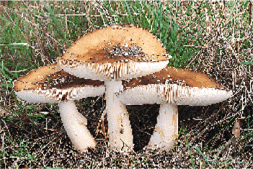Gather ye rosebuds while ye may -- but avoid the mushrooms
CMAJ 1997;157:431© 1997 Canadian Medical Association
Physicians should be alert to the symptoms and signs of mushroom poisoning. Most cases result from people eating wild mushrooms that they have identified incorrectly. Over 90% of reported cases of mushroom poisoning world wide are likely caused by ingestion of Amanita species, especially A. phalloides (the "death cap" mushroom). Four cases of A. phalloides poisoning were recently reported from Northern California.1 The Amanita genus includes poisonous and edible species that resemble one another; hence there is potential for a fatal error.
Amanita species are found primarily in cool wet areas. The mature cap varies in colour from white to shades of yellow, green and light brown. The cap of A. phalloides is usually metallic green but can vary from light yellow to greenish brown. There is no distinct taste, and the toxins are not destroyed by cooking or drying. They are taken up by hepatocytes, where they interfere with messenger RNA synthesis, thereby suppressing protein production. Severe acute hepatitis results. Symptoms typically do not arise until several hours after the mushrooms are eaten; thus patients and physicians may not attribute the illness to mushroom poisoning, and appropriate intervention may be delayed.

Amanita pantherina. This species, which occurs in Canada and the US, contains ibotenic acid and other toxins. It can induce hallucinations but has also caused severe and even fatal poisonings. Photo by Dr. Scott Redhead, ECORC, Agriculture and Agri-Food Canada, Ottawa.
Symptoms of poisoning typically progress in 3 stages. The first stage, beginning within 612 hours of ingestion, is usually characterized by vomiting and profuse diarrhea and may include abdominal pain, fever, tachycardia, hyperglycemia, hypotension and electrolyte imbalance. During the next 2448 hours symptoms may improve even though hepatic and renal function continues to deteriorate. During this time, transaminase and bilirubin levels become elevated and tend to peak on about the fourth day. The prothrombin time will also be prolonged. During the third stage, 35 days after ingestion, hepatocellular damage and renal failure can progress, potentially resulting in hepatic coma and death by day 47. Other possible sequelae are cardiomyopathy, coagulopathy and seizures. The rate of death from A. phalloides poisoning is 20%30%.
There is no specific antidote. Early, vigorous intravenous fluid replacement and correction of electrolyte imbalance are essential; correction of coagulopathy may also be indicated. Gastric lavage should be performed and repeated doses of activated charcoal administered to remove any undigested mushroom and interrupt absorption of the toxin. Hemodialysis may be helpful if initiated within 24 hours of ingestion. Some patients will require a liver transplant.
Wild mushrooms should not be eaten unless they have been identified as nonpoisonous by a competant mycologist. Field guides may help amateur botanists to identify mushrooms but do not give enough detail to allow the layperson to reliably distinguish toxic from nontoxic species. -- JH, AMT
Reference
- Amanita phalloides mushroom poisoning -- Northern California, January 1997. MMWR 1997;46:489-92.
Send a letter to the editor responding to this article
Envoyez une lettre à la rédaction au sujet de cet article
| CMAJ August 15, 1997 (vol 157, no 4) / JAMC le 15 août 1997 (vol 157, no 4) |